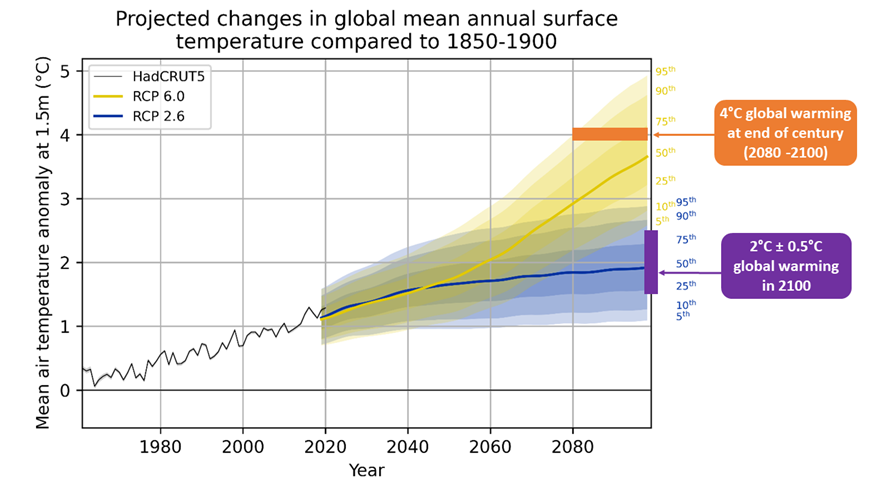Met Office
|
|
Using Met Office climate science to map future risks
Every five years the UK government is required to publish a Climate Change Risk Assessment (CCRA). The purpose of the assessment is to set out the risks and opportunities facing the UK from climate change. The 3rd CCRA was presented to Parliament on Monday 17th January 2022 and will help inform both mitigation and adaptation strategies.
A major component the CCRA relies upon is the Technical Report, which provides an independent scientific foundation for the risk assessment to be built on. Bringing this important section together for use in the latest assessment was a mammoth task with over 450 experts working for more than three years, led by the University of Exeter in partnership with the Met Office.
The Technical Report for the latest CCRA was published in June 2021, you can read more about the report and how it was developed in our blog.
The report examined the consequences of global warming of 2°C and 4°C above pre-industrial levels and the extent to which we are prepared for these. The 2°C case is typically reached through emission reduction scenarios that are similar (but not quite as strict) to those needed to limit median warming to well below 2°C or 1.5°C, as required by the Paris agreement.
The 4°C warming level can be reached via a range of emissions scenarios, including those with emissions within the range corresponding to current policies and those where emissions back-track on existing policies and agreements. For the former, stronger climate feedbacks are required to reach 4°C. For the latter, the warming level can be reached with more modest climate feedbacks. The Met Office’s UKCP18 projections, funded by BEIS and Defra, were a key source of information for the risk assessment, providing information for both 2°C and 4°C of warming.
Director of the Technical Report, Professor Richard Betts MBE, said: “By establishing that under current emissions commitments 4°C of global warming is still a possibility, our results suggest that we cannot be complacent about the potential to reach this severe level of warming. Although the chances of reaching 4°C of global warming this century are becoming smaller, especially with the additional pledges made at COP26 in November, it is still a scenario we could see even with current levels of ambition on emissions cuts.
“Because the impacts of climate change become more amplified the hotter the global average temperature gets, it’s important to examine even these less likely eventualities so we can understand the risks we are taking by not reducing emissions rapidly, and see what ultimately may need to be done through adaptation to try to limit the damage if we fail to do this.”
With rising global temperatures, we are edging closer to the thresholds for more and more so-called ‘High Impact, Low Likelihood’ (HILL) events. HILL events go beyond traditional weather extremes, potentially taking the climate system into uncharted territories, providing a challenge for risk assessments such as CCRA3. You can read more about HILL events and why scientists are calling for more research into the challenge they provide in our recent blog article.

The graph above shows how global temperature rises of 4°C by 2100 are still possible under current emissions commitments, although the likelihood is decreasing, especially after the additional pledges made at COP26. Analysis in CCRA3 found that the emissions scenario known as “RCP6.0” was within the range of outcomes consistent with current policies as of mid-2021. CCRA3 also considered a scenario of limiting global warming to around 2°C, illustrated here with the RCP2.6. The yellow and blue plumes show the likelihood of different global temperature change pathways with these 2 scenarios in the UKCP18 climate projections.
The UKCP18 projections were also used to investigate a number of specific risks linked to increased flooding, drought, wildfire and sea level rise arising from global warming reaching 2°C and 4°C by 2100. Additionally, the projections informed an assessment of interacting and cascading risks. The Technical Report team also drew on a large number of previous studies of other risks using other climate projections, and mapped these to the framework of 2°C and 4°C warming by 2100.
Professor Betts added: “The UK Climate Projections provided crucial, state-of-the-art information to underpin the risk assessment in CCRA3. The close interaction between climate scientists, impacts researchers and stakeholders also helped us see how additional analysis and new projections can help inform future assessments.”
The content of the Technical Report was discussed at an event during COP26 in Glasgow. You can watch the event, at which Professor Betts was on the panel, on the UK Government YouTube channel.
Work to underpin the technical report for the next CCRA is already underway.
Original article link: https://blog.metoffice.gov.uk/2022/02/15/using-met-office-climate-science-to-map-future-risks/


